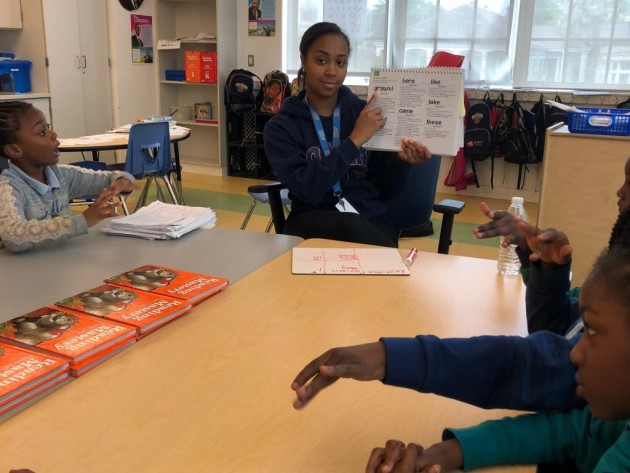Two blocks from the Anacostia Metro station and the bus terminal, across Martin Luther King Jr. Blvd., passed the staring of unfamiliar faces, men in cars honking and bordered-up homes, Jimmie L. Benbow unloads his merchandise from the white van onto a nearby table and begins to set up shop.
A young brown-skin girl shuffles past and hurries into King’s Café Carryout at 2100 Martin Luther King Jr. Blvd, in Southeast just before the 2 p.m. closing time.
“Where you going?” asked Benbow, a vendor who sells colorful oils, soaps, socks and black hair care products on the boulevard.
She paused in her tracks, looked at Benbow and pointed to her destination. It was a bone-chilling, sunny Saturday afternoon in January. The young girl wore a white bubble jacket with a pink hoody. Both were unzipped.
“You better zip up that jacket,” Benbow said. She didn’t respond. She exits the carryout grasping a brown paper bag and heads two doors down into Salon Exquisite where women sat with their legs crossed and their heads down as the beauticians worked their magic.
Across the street, in Riverview Plaza is what many Washingtonians describe as the “Big Chair,” suitable for none other than a giant. It was once the world’s largest chair made of solid Honduran mahogany, standing at 19 ½ feet tall and weighs 4,600 pounds. It was presented to the Curtis Brothers for their outstanding leadership and service to the public by the Bassett Furniture Industries and dedicated on July 11, 1959.
“Aight my brother,” Benbow said as he nodded at an older man as he walked by. Benbow, 62, sported a service hat, a black jacket and thick black gloves. He knew many passersby and greeted them courteously.
Beside Benbow were two other vendors who also sold socks, President Barack Obama apparel and batteries. Benbow didn’t say much to them. One blasted the WHUR radio station, which played a series of oldies but goodies.
Twenty minutes after the hour, people began to make their way toward the vendors. Two older gentlemen approached the vendor with the radio, giving him a dap – a firm clasp of the right hands and a masculine hug.
Another vendor joins the trio and the four of them casually chat for a moment.
As I made my way up the boulevard, a tall light-skinned, curly Sue, bopped to the go-go beat bumping in her headphones.
Just a few feet away on the left side of the Troyit’s Barbershop, a mural read “Many voices, many beats, one city,” and musical notes floated against the pink background in a city of colorful stereo buildings.
The tunes of Marvin Gaye boomed through the speakers of a white Toyota 4×4 pick-up truck, parked in the nearby field.
Further up the field, a small lady holds a baby on the right side of her hip and waves her free arm. Four other children hurry toward her.
“I like your boots,” said a young female.
“Thank you,” said Diasia Ellerbee, 23, who was standing on the corner of Sheridan Road and Martin Luther King Jr. Blvd., making her way toward the Metro.
Ellerbee’s boot admirer had a baby on her hip and yellow and blue barrettes in her hair. Three children, a younger girl with the same hairstyle and two small boys no older than four, followed behind her across the boulevard as cars waited for them to pass.
She was the person in the field just moments ago. She is 10 years old. The children with her were her siblings.
Ellerbee and I helped the girl to the bus terminal where the five sat on the metal bench and waited for the A6. The baby she held had no shoes, just blue stripped socks. He had a jacket but no hat nor hood on his head.
One of her other brothers looked as if he had been crying. Tears stained his face, leaving dry trails down his cheeks. Green mucus filled his tiny nostrils.
I pulled some wrinkled tissue from my bag and wiped his nose. His jacket and hoody were unzipped. I zipped his jacket and placed the hood on his bare head.
“Is he sick,” I asked the 10-year-old girl.
“I gave him his medicine,” the younger sister responded. None of the children had gloves.
The eldest girl said that her mother had given her money for food and that the five of them were headed to her Uncle Kenny’s house.
According to So Others Might Eat, an interfaith-based organization that works to help the poor and homeless in D.C. reported that the District has the highest rate of children in poverty of any jurisdiction in the U.S. Thirty-three percent of D.C. children live in families below the poverty level as compared to 18 percent in the U.S. as a whole. In 2005, nearly 1 in 5 or 19.8 percent of the District’s residents lived in poverty compared to 13.3 percent in the entire nation.
The bus arrived. Ellerbee and I helped the girl and her siblings onto the bus. Ellerbee began to call the girl’s uncle to make sure he knew the children were coming. We exited the bus and watched them from the window as the bus pulled off.


